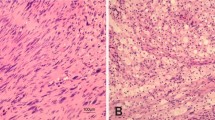Abstract
To analyze the effect of Gamma Knife radiosurgery (GKS) on tumor control and hearing preservation rates in patients with vestibular schwannomas (VS) in a setting of neurofibromatosis type 2 (NF 2), a retrospective study was carried out at a tertiary-level referral Gamma Knife unit. Dose plans, pre- and postoperative radiology, and follow-up clinical records of patients with NF 2 who had undergone GKS for VS using a Leksell Gamma Knife (Elekta Instruments AB, Stockholm, Sweden) model B unit from 1997 to 2008 were reviewed. Thirty patients with 54 VS underwent GKS. The average age of the cohort was 29 years (range 10–56 years). Twenty-four patients had bilateral VS. The commonest clinical presentation was hearing loss and tinnitus. Primary GKS was given to 36 tumors, while 18 tumors received it as an adjunct to surgery. Average tumor size was 3.7 cc (range 0.1–13.3 cc). A median 12 Gy prescription dose (range 10–15 Gy) was administered at the 50% isodose (range 42–50%) to cover on average 91.5% of the tumor. Eighteen patients were available for clinical, 14 patients for radiological, and 5 patients (with useful hearing) for audiometric follow-up at an average of 26.6 months. The tumor control rate was 87.5% in this series (33.3% tumor regression), while hearing preservation was noted in 66.7% of cases. One patient developed worsening of facial function. GKS for VS provides satisfactory tumor control and hearing preservation in patients with NF 2. Long-term follow-up will determine future recommendations.



Similar content being viewed by others
References
Evans DG, Baser ME, O’Reilly B, Rowe J, Gleeson M, Saeed S et al (2005) Management of the patient and family with neurofibromatosis 2: a consensus conference statement. Br J Neurosurg 19:5–12
Gutmann DH, Aylsworth A, Carey JC, Korf B, Marks J, Pyeritz RE et al (1997) The diagnostic evaluation and multidisciplinary management of neurofibromatosis 1 and neurofibromatosis 2. JAMA 278:51–57
National Institutes of Health (1988) Consensus development conference: neurofibromatosis conference statement. Arch Neurol 45:575–578
Hasegawa T, Fujitani S, Katsumata S, Kida Y, Yoshimoto M, Koike J (2005) Stereotactic radiosurgery for vestibular schwannomas: analysis of 317 patients followed more than 5 years. Neurosurgery 57:257–265
Lunsford LD, Niranjan A, Flickinger JC, Maitz A, Kondziolka D (2005) Radiosurgery of vestibular schwannomas: summary of experience in 829 cases. J Neurosurg 102:195–199
Pollock BE, Driscoll CL, Foote RL, Link MJ, Gorman DA, Bauch CD et al (2006) Patient outcomes after vestibular schwannoma management: a prospective comparison of microsurgical resection and stereotactic radiosurgery. Neurosurgery 59:77–85
Kida Y, Kobayashi T, Tanaka T, Mori Y (2000) Radiosurgery for bilateral neurinomas associated with neurofibromatosis type 2. Surg Neurol 53:383–390
Mathieu D, Kondziolka D, Flickinger JC, Niranjan A, Williamson R, Martin JJ et al (2007) Stereotactic radiosurgery for vestibular schwannomas in patients with neurofibromatosis type 2: an analysis of tumor control, complications, and hearing preservation rates. Neurosurgery 60:460–468
Phi JH, Kim DG, Chung HT, Lee J, Paek SH, Jung HW (2009) Radiosurgical treatment of vestibular schwannomas in patients with neurofibromatosis type 2: tumor control and hearing preservation. Cancer 115:390–398
Roche PH, Regis J, Pellet W, Thomassin JM, Gregoire R, Dufour H et al (2000) Neurofibromatosis type 2: preliminary results of Gamma Knife radiosurgery of vestibular schwannomas. Neurochirurgie 46:339–354 (Fr)
Rowe JG, Radatz MW, Walton L, Soanes T, Rodgers J, Kemeny AA (2003) Clinical experience with Gamma Knife stereotactic radiosurgery in the management of vestibular schwannomas secondary to type 2 neurofibromatosis. J Neurol Neurosurg Psychiatry 74:1288–1293
Clark JG (1981) Uses and abuses of hearing loss classification. ASHA 23:493–500
Antinheimo J, Sankila R, Carpén O, Pukkala E, Sainio M, Jääskeläinen J (2000) Population-based analysis of sporadic and type 2 neurofibromatosis-associated meningiomas and schwannomas. Neurology 54:71–76
Evans DG, Huson SM, Donnai D, Neary W, Blair V, Teare D et al (1992) A genetic study of type 2 neurofibromatosis in the United Kingdom, I: prevalence, mutation rate, fitness, and confirmation of maternal transmission effect on severity. J Med Genet 29:841–846
Samii M, Matthies C, Tatagiba M (1997) Management of vestibular schwannomas (acoustic neuromas): auditory and facial nerve function after resection of 120 vestibular schwannomas in patients with neurofibromatosis 2. Neurosurgery 40:696–706
Nitta T, Sato K (1995) A clinical study of 21 patients with neurofibromatosis I and II. No Shinkei Geka 23:131–135 (Jpn)
Perks JR, St George EJ, El Hamri K, Blackburn P, Plowman PN (2003) Stereotactic radiosurgery XVI: isodosimetric comparison of photon stereotactic radiosurgery techniques (Gamma Knife vs. micromultileaf collimator linear accelerator) for acoustic neuroma–and potential clinical importance. Int J Radiat Oncol Biol Phys 57:1450–1459
Chopra R, Kondziolka D, Niranjan A, Lunsford LD, Flickinger JC (2007) Long-term follow-up of acoustic schwannoma radiosurgery with marginal tumor doses of 12–13 Gy. Int J Radiat Oncol Biol Phys 68:845–851
Balasubramaniam A, Shannon P, Hodaie M, Laperriere N, Michaels H, Guha A (2007) Glioblastoma multiforme after stereotactic radiotherapy for acoustic neuroma: case report and review of the literature. Neuro Oncol 9:447–453
Bari ME, Forster DM, Kemeny AA, Walton L, Hardy D, Anderson JR (2002) Malignancy in a vestibular schwannoma: report of a case with central neurofibromatosis, treated by both stereotactic radiosurgery and surgical excision, with a review of the literature. Br J Neurosurg 16:284–289
Conflict of interest statement
None.
Author information
Authors and Affiliations
Corresponding author
Rights and permissions
About this article
Cite this article
Sharma, M.S., Singh, R., Kale, S.S. et al. Tumor control and hearing preservation after Gamma Knife radiosurgery for vestibular schwannomas in neurofibromatosis type 2. J Neurooncol 98, 265–270 (2010). https://doi.org/10.1007/s11060-010-0181-1
Received:
Accepted:
Published:
Issue Date:
DOI: https://doi.org/10.1007/s11060-010-0181-1




